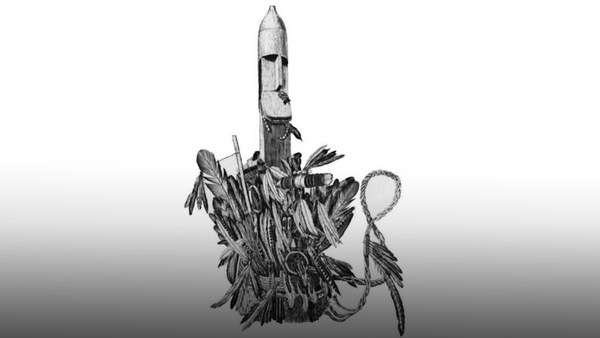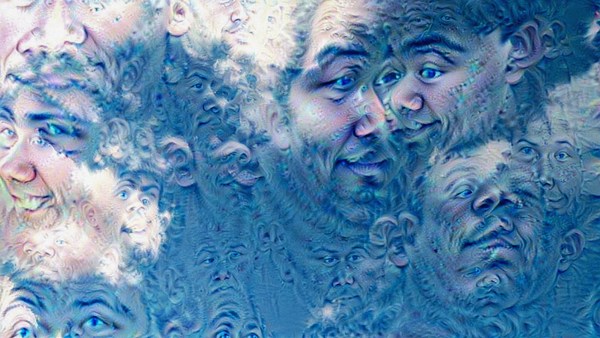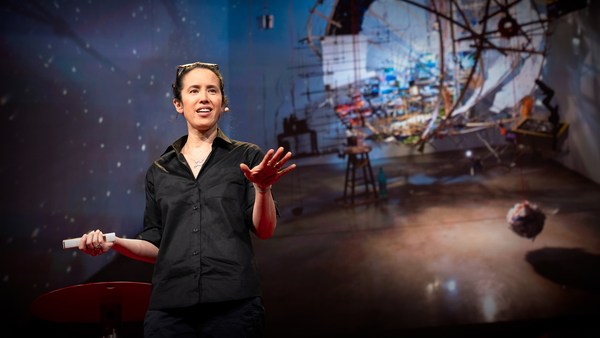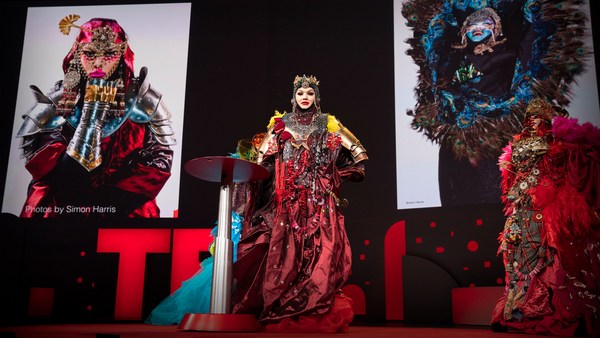Take a look at this work of art. What is it that you see? At first glance, it looks to be a grandfather clock with a sheet thrown over it and a rope tied around the center. But a first look always warrants a second. Look again. What do you see now? If you look more closely, you'll realize that this entire work of art is made from one piece of sculpture. There is no clock, there is no rope, and there is no sheet. It is one piece of bleached Honduras mahogany.
Now let me be clear: this exercise was not about looking at sculpture. It's about looking and understanding that looking closely can save a life, change your company and even help you understand why your children behave the way they do. It's a skill that I call visual intelligence, and I use works of art to teach everybody, from everyday people to those for whom looking is the job, like Navy SEALs and homicide detectives and trauma nurses.
The fact is that no matter how skilled you might be at looking, you still have so much to learn about seeing. Because we all think we get it in a first glance and a sudden flash, but the real skill is in understanding how to look slowly and how to look more carefully. The talent is in remembering -- in the crush of the daily urgencies that demand our attention -- to step back and look through those lenses to help us see what we've been missing all along.
So how can looking at painting and sculpture help? Because art is a powerful tool. It's a powerful tool that engages both sight and insight and reframes our understanding of where we are and what we see.
Here's an example of a work of art that reminded me that visual intelligence -- it's an ongoing learning process and one that really is never mastered. I came across this quiet, seemingly abstract painting, and I had to step up to it twice, even three times, to understand why it resonated so deeply. Now, I've seen the Washington Monument in person thousands of times, well aware of the change in the color of marble a third of the way up, but I had never really looked at it out of context or truly as a work of art. And here, Georgia O'Keeffe's painting of this architectural icon made me realize that if we put our mind to it, it's possible to see everyday things in a wholly new and eye-opening perspective.
Now, there are some skeptics that believe that art just belongs in an art museum. They believe that it has no practical use beyond its aesthetic value. I know who they are in every audience I teach. Their arms are crossed, their legs are crossed, their body language is saying, "What am I going to learn from this lady who talks fast about painting and sculpture?" So how do I make it relevant for them? I ask them to look at this work of art, like this portrait by Kumi Yamashita. And I ask them to step in close, and even closer still, and while they're looking at the work of art, they need to be asking questions about what they see. And if they ask the right questions, like, "What is this work of art? Is it a painting? Is it a sculpture? What is it made of?" ... they will find out that this entire work of art is made of a wooden board, 10,000 nails and one unbroken piece of sewing thread.
Now that might be interesting to some of you, but what does it have to do with the work that these people do? And the answer is everything. Because we all interact with people multiple times on a daily basis, and we need to get better at asking questions about what it is that we see.
Learning to frame the question in such a way as to elicit the information that we need to do our jobs, is a critical life skill. Like the radiologist who told me that looking at the negative spaces in a painting helped her discern more discreet abnormalities in an MRI. Or the police officer who said that understanding the emotional dynamic between people in a painting helped him to read body language at a domestic violence crime scene, and it enabled him to think twice before drawing and firing his weapon. And even parents can look to see absences of color in paintings to understand that what their children say to them is as important as what they don't say.
So how do I -- how do I train to be more visually intelligent? It comes down to four As. Every new situation, every new problem -- we practice four As. First, we assess our situation. We ask, "What do we have in front of us?" Then, we analyze it. We say, "What's important? What do I need? What don't I need?" Then, we articulate it in a conversation, in a memo, in a text, in an email. And then, we act: we make a decision. We all do this multiple times a day, but we don't realize what a role seeing and looking plays in all of those actions, and how visual intelligence can really improve everything.
So recently, I had a group of counterterrorism officials at a museum in front of this painting. El Greco's painting, "The Purification of the Temple," in which Christ, in the center, in a sweeping and violent gesture, is expelling the sinners from the temple of prayer. The group of counterterrorism officials had five minutes with that painting, and in that short amount of time, they had to assess the situation, analyze the details, articulate what, if anything, they would do if they were in that painting. As you can imagine, observations and insights differed. Who would they talk to? Who would be the best witness? Who was a good potential witness? Who was lurking? Who had the most information? But my favorite comment came from a seasoned cop who looked at the central figure and said, "You see that guy in the pink?" -- referring to Christ -- he said, "I'd collar him, he's causing all the trouble."
(Laughter)
So looking at art gives us a perfect vehicle to rethink how we solve problems without the aid of technology. Looking at the work of Felix Gonzalez-Torres, you see two clocks in perfect synchronicity. The hour, minute and second hand perfectly aligned. They are installed side by side and they're touching, and they are entitled "'Untitled' (Perfect Lovers)." But closer analysis makes you realize that these are two battery-operated clocks, which in turn makes you understand -- "Hey, wait a minute ... One of those batteries is going to stop before the other. One of those clocks is going to slow down and die before the other and it's going to alter the symmetry of the artwork." Just articulating that thought process includes the necessity of a contingency plan. You need to have contingencies for the unforeseen, the unexpected and the unknown, whenever and however they may happen.
Now, using art to increase our visual intelligence involves planning for contingencies, understanding the big picture and the small details and noticing what's not there. So in this painting by Magritte, noticing that there are no tracks under the train, there is no fire in the fireplace and there are no candles in the candlesticks actually more accurately describes the painting than if you were to say, "Well, there's a train coming out of a fireplace, and there are candlesticks on the mantle."
It may sound counterintuitive to say what isn't there, but it's really a very valuable tool. When a detective who had learned about visual intelligence in North Carolina was called to the crime scene, it was a boating fatality, and the eyewitness told this detective that the boat had flipped over and the occupant had drowned underneath. Now, instinctively, crime scene investigators look for what is apparent, but this detective did something different. He looked for what wasn't there, which is harder to do. And he raised the question: if the boat had really tipped flipped over -- as the eyewitness said that it did -- how come the papers that were kept at one end of the boat were completely dry? Based on that one small but critical observation, the investigation shifted from accidental death to homicide.
Now, equally important to saying what isn't there is the ability to find visual connections where they may not be apparent. Like Marie Watt's totem pole of blankets. It illustrates that finding hidden connections in everyday objects can resonate so deeply. The artist collected blankets from all different people in her community, and she had the owners of the blankets write, on a tag, the significance of the blanket to the family. Some of the blankets had been used for baby blankets, some of them had been used as picnic blankets, some of them had been used for the dog. We all have blankets in our homes and understand the significance that they play. But similarly, I instruct new doctors: when they walk into a patient's room, before they pick up that medical chart, just look around the room. Are there balloons or cards, or that special blanket on the bed? That tells the doctor there's a connection to the outside world. If that patient has someone in the outside world to assist them and help them, the doctor can implement the best care with that connection in mind. In medicine, people are connected as humans before they're identified as doctor and patient.
But this method of enhancing perception -- it need not be disruptive, and it doesn't necessitate an overhaul in looking. Like Jorge Méndez Blake's sculpture of building a brick wall above Kafka's book "El Castillo" shows that more astute observation can be subtle and yet invaluable. You can discern the book, and you can see how it disrupted the symmetry of the bricks directly above it, but by the time you get to the end of the sculpture, you can no longer see the book. But looking at the work of art in its entirety, you see that the impact of the work's disruption on the bricks is nuanced and unmistakable. One thought, one idea, one innovation can alter an approach, change a process and even save lives.
I've been teaching visual intelligence for over 15 years, and to my great amazement and astonishment -- to my never-ending astonishment and amazement, I have seen that looking at art with a critical eye can help to anchor us in our world of uncharted waters, whether you are a paramilitary trooper, a caregiver, a doctor or a mother. Because let's face it, things go wrong.
(Laughter)
Things go wrong. And don't misunderstand me, I'd eat that doughnut in a minute.
(Laughter)
But we need to understand the consequences of what it is that we observe, and we need to convert observable details into actionable knowledge. Like Jennifer Odem's sculpture of tables standing sentinel on the banks of the Mississippi River in New Orleans, guarding against the threat of post-Katrina floodwaters and rising up against adversity, we too have the ability to act affirmatively and affect positive change.
I have been mining the world of art to help people across the professional spectrum to see the extraordinary in the everyday, to articulate what is absent and to be able to inspire creativity and innovation, no matter how small. And most importantly, to forge human connections where they may not be apparent, empowering us all to see our work and the world writ large with a new set of eyes.
Thank you.
(Applause)





